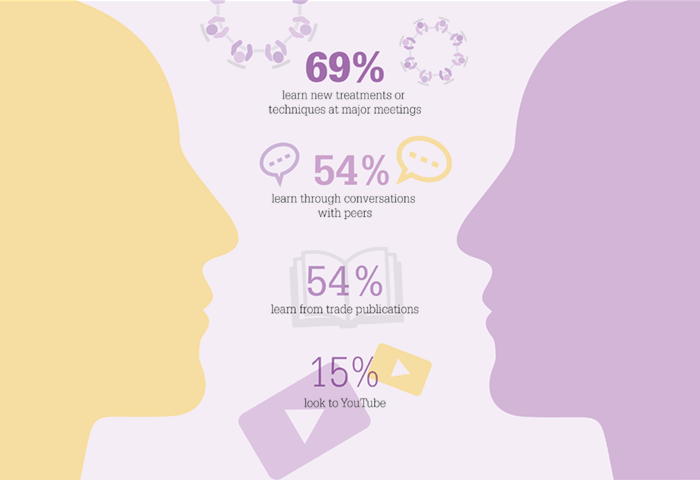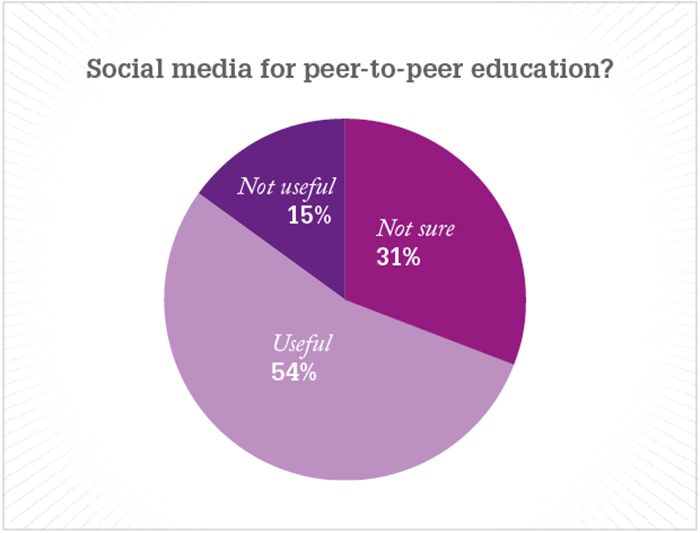
- As eyecare constantly advances, the knowledge and skills of ophthalmologists must keep pace
- Peer-to-peer education is one key method of keeping up-to-date
- Several leading ophthalmologists who frequently teach and learn from their peers were surveyed
- We share their thoughts on the value of peer-to-peer education, and how best to approach it.
Anyone who has spent time in the crowded lecture halls of a national meeting will have seen physicians seeking out opportunities for peer-to-peer education. But the lecture hall isn’t the only venue; ophthalmologists also share knowledge and learn through one-on-one discussions, publications, webinars and videos. In March 2018, we conducted an email survey with 25 ophthalmologists working in multiple subspecialties in North America and Europe, as well as industry professionals, to gain perspectives on peer-to-peer education from the ophthalmology community. All participants were asked about how they view such education, where and how they prefer to give and receive it, and how taking on the role of educator has influenced their careers. From this diverse group, we identified some clear trends and a few surprises.
Assessing value
When physicians were asked about the perceived value of peer-to-peer education, several recipients offered comments on how they both learn and educate others in this mode. Joshua Mali (The Eye Associates, Sarasota, FL, USA) described peer-to-peer education as a “critical component of life-long learning,” adding, “it helps to establish the standard of care, advance our field, and provide new ideas and innovations to the ophthalmology community.” Peer-to-peer education takes many forms, as described by Cynthia Matossian (Matossian Eye Associates, Mercer County, NJ, and Bucks County, PA, USA): “Sharing knowledge with peers is how we stay abreast of current developments in ophthalmology, whether through sponsored webinars, one-on-one calls with eyecare providers, lectures, presentations, or panel discussions at local or international meetings.” But what methods of education are preferred? Interaction in small groups or one-on-one are highly valued, with respondents noting that intimate environments encourage a greater depth of learning and bonding among colleagues. Several physicians acknowledged the ‘immediacy’ of peer-to-peer education, which, according to Sumit Garg (Gavin Herbert Eye Institute, University of California, Irvine, CA, USA), often lets physicians learn about “technologies, techniques, and medications prior to randomized clinical trials or peer-reviewed published papers.”New horizons
To delve into the written word in peer-to-peer education, we asked, “What was the last article you read that made you think, ‘I need to learn how to do this’?” Responses pertaining to cataract surgery included the Yamane technique for scleral haptic fixation, capsular ring techniques, and the RxSight light-adjustable IOL (RxSight, Inc). Refractive topics of interest included ReLex SMILE (Zeiss), wavefront-guided LASIK combined with SMILE, topo-guided LASIK in irregular corneas, as well as new corneal inlays. Other topics included ab-interno canaloplasty (ABiC; Ellex) for glaucoma, corneal transplant with “grip and rip” anterior lamellar keratoplasty (ALK) and Luxturna gene therapy (voretigene neparvovec-rzyl, Spark Therapeutics) for inherited retinal disease. Ophthalmologists reported looking to a variety of sources for more information on these advances, with the majority learning more about the treatment or technique at major meetings (Figure 1). A plethora of publications exist in the ophthalmology field – but how frequently are they read? On average, the physicians reported referencing ophthalmology trade publications online or in print 9.8 times per month, with 31 percent reading 20 or more times. Several respondents said they get information through meetings or other means and only access articles when they are putting together presentations, whereas others said they read the ophthalmology literature “constantly.” Next, we asked if subscriptions and paywalls present any frustration? Most physicians reported that academic journal paywalls hadn’t blocked them from reading an article (62 percent), and many said they subscribe to the journals or work at institutions that subscribe. Others reported dissatisfaction with paying or using the varied methods to access the journals. Although Amir Hamid (Optegra Eye Health Care, London, UK) has not allowed paywalls to stand in his way, he noted, “[they can] represent a significant barrier to dissemination of knowledge to a wider audience.” Perhaps this is why 92 percent of respondents find it important that their own educational content is published in a free-to-read publication.Industry events versus CME
Our survey respondents have given many CME and podium lectures, and participated in numerous industry panels. But do these different environments – academic, CME and industry sponsored – affect the content or quality of the material shared? Yes, according to 64 percent; respondents noted that industry-sponsored and academic environments are different – but both have value. Identified advantages of industry events were learning about new drugs or technologies and their ‘on-label’ uses; CME was identified as offering more ‘freedom’ to share on- and off-label uses, answer questions and have a more candid, unconstrained discussion. One doctor noted that non-industry, non-CME presentations offer the most flexibility, but all respondents who present at industry events said that they offer their honest experiences, unaffected by the sponsor’s influence. “Education has changed greatly over the past several years,” observed Eric Donnenfeld (Ophthalmic Consultants of Long Island and Connecticut, NY and CT, USA). “Due to strict guidelines, most industry-sponsored talks have become very cut-and-dried, with no room for going off the legal department-approved script, much less off-label.” Matossian agreed with Donnenfeld, but also made the point that “industry-sponsored roundtable talks play a key role in disseminating information when a new drug or device is launched.”Social media and digital access
What about accessing peer-to-peer education outside of major meetings? Online presentations, such as convenient and cost-effective live webinars and videos, were well-appreciated by respondents. Is social media genuinely useful for peer-to-peer education? Yes, according to over half of the doctors (Figure 2). Positive comments related mostly to streaming or sharing videos via social media channels. “Social media gives you access to a wide audience with a few taps on the keyboard,” said Hamid. “While on an educational tour of India, we used this form of communication to access a large number of ophthalmologists without having to travel the length and breadth of a huge country. They could participate in Q&A sessions in the comfort of their own local clinics, hospitals and universities.” Those doctors less certain about the potential of social media (with “no” or “not sure” responses) noted that they are open to the possibility in the future. Whilst one respondent reported using social media to share educational content with colleagues, another thought that social media channels lack the necessary depth for education but do help “provide insight or intrigue.” One respondent reported that social media channels are “not at all” useful for education because content tends to be promotional.
PR machine
Physicians who educate their peers at conferences and other events invariably raise their professional profiles and their practices’ visibility. When we asked if the doctors use educational opportunities to market themselves and their practices, a large majority of respondents (77 percent) said they see the positive effects of education on their reputations, but many said they do not educate with marketing in mind. “I do not see it as marketing,” Hamid stated. “But educational opportunities do increase your profile and lend credibility to what you say in the context of patient consultations in your practice.” Lisa Nijm (Warrenville Eyecare and LASIK, Warrenville, IL, USA) agreed: “I don’t use educational opportunities with the goal of marketing my practice in mind, but I certainly believe there is an additional benefit: other practices have learned of the different specialty procedures I perform and complex conditions I treat, and that has resulted in additional referrals.” As Donnenfeld pointed out, “Doctors like to refer to thought leaders.” Mali said that educating his peers has “helped to build my strong reputation on the national and international stage.” For those physicians who want to expand their visibility through peer-to-peer education, Nathan Radcliffe (New York Eye and Ear Infirmary, New York City, NY, USA) offered some advice: “I think the key is to ‘pound the pavement’ and try to achieve a diversity of visibility, including trade and peer-reviewed publications, major meetings, email marketing, online videos and paid promotional events. The payoff is gradual and quite modest.” Some direct marketing efforts cited by the respondents included providing education for the public and for referring ODs, as well as promoting or highlighting educational events on social media.As a follow-up to our physician survey, we asked decision-makers in industry how they develop peer-to-peer education on their emerging ophthalmic technologies. Here are a few key insights. Preferred method of educating physicians about company products?
- “Advertisements help maintain a product’s visibility, but for greater impact and to provide the potential user with more information, I focus on trade articles or advertorials.”
- “I like to create educational resources (print, podium, digital) focused directly at the end user/buyer.”
- “Trade articles, CME meetings, industry meetings and webinars are all effective educational tools. I don’t see an advertisement as an educational tool unless it’s a sponsored article or supplement.”
- “It’s difficult to educate in less than 250 characters. Social media is more useful for building awareness and keeping our products top of mind. It can be a useful way to point to an educational source – for example, we use social media and eblasts to point to webinars.”
- “I see the utility of social media in expanding one’s presence, however, I’m more old school and like to stick with getting KOLs focused on podium presentations or product-driven articles.”
- “I use digital media or create practice-building materials as additional tools outside of the product to reach the end user or supporting staff.”
